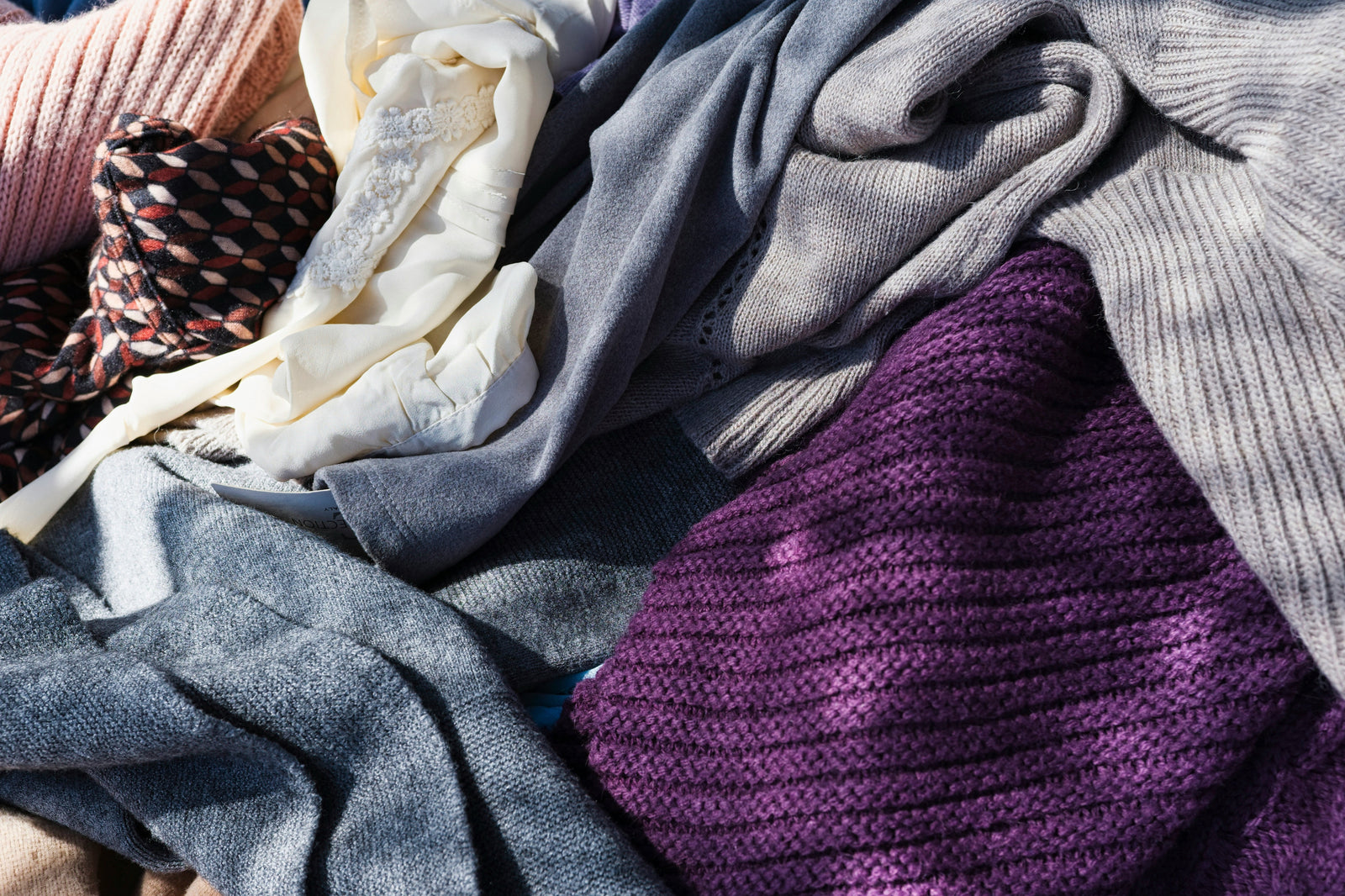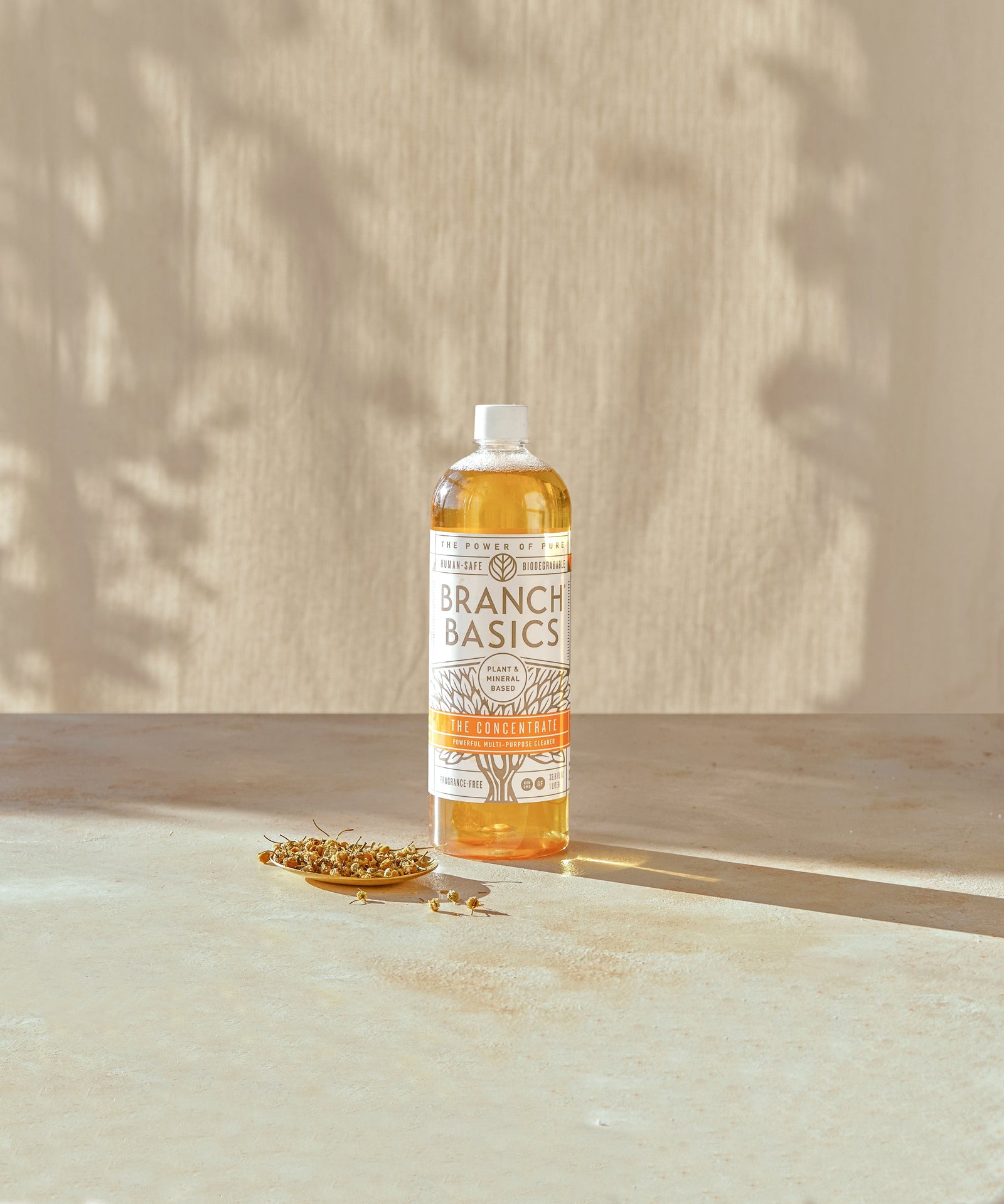How To Handwash Clothes Using Branch Basics

Branch Basics is perfect for handwashing clothes, including delicates and even many dry-clean-only items.
But, there’s a right way to use it.
Although you can use Branch Basics Laundry Dilution (liquid), Branch Basics Concentrate (undiluted) is typically the best product for handwashing most types of clothes.
Read on to learn all about how to handwash clothes naturally using Branch Basics, including what types of clothes require handwashing, general handwashing instructions, and specific instructions for different types of clothes.
What Types Of Clothing Requires Handwashing?
You can determine the type of clothes that require handwashing by reading the care label.
The hand-wash symbol looks like a hand in a bucket of water.
Generally, handwashing is recommended for:
- Cashmere
- Wool
- Silk
- Clothing with embellishments such as beading, special stitching, glitter, etc.
- Some types of bras, underwear, and lingerie
- Knit sweaters
- Many dry-clean-only clothes can also be hand-washed (more on this to come)
Need help decoding those care labels? Check out Cleaning Laundry Symbols: Here’s What They Mean for all the details.
Why Is Branch Basics Safe For Handwashing?
Branch Basics is ideal for handwashing delicates because it’s 100% plant-based, liquid, and free from harsh detergents, optical brighteners, bleach, ammonia, sulfates, fragrance, and other ingredients that can degrade fabric quality over time (not to mention your health!).
It’s also MADE Safe Certified, biodegradable, and incredibly gentle on the skin (even sensitive skin) and hands.
As mentioned previously, we recommend using Branch Basics Concentrate undiluted for handwashing all types of clothes, and Branch Basics All-Purpose for stain removal.
We generally do not recommend Oxygen Boost for delicates, due to its natural bleaching properties.
If you’ve run out of Concentrate, Branch Basics Laundry Dilution (liquid) is a good second-best.
Branch Basics Laundry Detergent is not recommended for handwashing delicate items, but it can be used for other types of handwashing. Please note that this product contains enzymes, which may irritate sensitive skin if it comes into direct contact.
General Instructions On How To Handwash Clothes With Branch Basics
Handwashing clothes with Branch Basics is quick, easy, and takes no special skills or equipment.
The key lies in using the right amount of Concentrate, warm water, optimal soaking time, gentle agitation, and drying. Here’s how.
Supplies Needed
- Branch Basics Concentrate
- Branch Basics All-Purpose (which is made from Concentrate) for stain removal
- Lukewarm water
- A sink, bowl, bucket, or basin
General Handwashing Instructions
- Pre-treat stains by spraying All-Purpose and gently agitating with a soft brush or cloth. Rinse to see if the stain has lifted; if not, repeat. Stubborn stains may need to sit for 15 minutes or more (see our Branch Basics Stain Master Guide for fabric- and stain-specific advice).
- Note: When pre-treating stains on silk, test a small area first by spraying a small amount of All Purpose, then wetting it.
- Note: When pre-treating stains on silk, test a small area first by spraying a small amount of All Purpose, then wetting it.
- Fill your sink, bowl, bucket, or basin with lukewarm or cool water and ½ teaspoon Branch Basics Concentrate.
- Soak your garment(s) for 15 - 30 minutes.
- Gently agitate with your hands, a wooden spoon, or tongs to help remove dirt, odors, and soil.
- Rinse by hand under cool or lukewarm water.
- Gently squeeze (without wringing) out excess water
- Dry by placing the items, one at a time, on a large towel and rolling up like a burrito, pressing as you go to release the water.
- Dry according to care tag instructions.
Related reading: How To Use Branch Basics All-Purpose: 47+ Ways
How To Handwash Sweaters (Knits, Cashmere, Wool)
Handwashing sweaters is an excellent way to extend their life and avoid any snags in the washing machine.
Instructions:
- Pre-treat stains by applying All-Purpose and gently agitating with a soft brush or cloth. Rinse to see if the stain has lifted; if not, repeat. Stubborn stains may require sitting for 15 minutes or more (see our Branch Basics Stain Master Guide for fabric- and stain-specific advice).
- Fill your sink, bowl, bucket, or basin with lukewarm or cool water and ½ teaspoon Branch Basics Concentrate.
- Soak for 15 - 30 minutes.
- Gently agitate with your hands or a wooden or stainless steel utensil to help remove dirt, odors, and soil.
- Gently rinse by hand under cool or lukewarm water.
- Gently squeeze (without wringing) out excess water.
- Dry by placing the items, one at a time, on a large towel and rolling up like a burrito, pressing as you go to release the water.
- Dry according to care tag instructions, which usually means drying them flat versus hanging.
How To Handwash Silks
Silks can be very delicate and require patience and a gentle hand, but can absolutely be washed at home.
Although some silks recommend machine washing, we tend to default to handwashing (most of the time!) to avoid any snags or damage from the washer or other clothes.
Here’s how to handwash them properly.
- If your silk has stains, wet then spray a small amount of Branch Basics All-Purpose in an inconspicuous place and let sit to ensure colorfastness. If it looks good, then pre-treat stains by applying All-Purpose and gently agitating with a cloth. Rinse to see if the stain has lifted; if not, repeat. Stubborn stains may require sitting for 15 minutes or more.
- See our Branch Basics Stain Master Guide for fabric- and stain-specific advice.
- See our Branch Basics Stain Master Guide for fabric- and stain-specific advice.
- Fill your sink, bowl, bucket, or basin with lukewarm or cool water and ½ teaspoon Branch Basics Concentrate.
- Soak for 15 - 30 minutes.
- Gently agitate with your hands or a wooden or stainless steel utensil to help remove dirt, odors, and soil.
- Gently rinse by hand under cool or lukewarm water.
- Gently squeeze (without wringing) out excess water.
- Dry by placing the items, one at a time, on a large towel and rolling up like a burrito, pressing as you go to release the water.
- Dry according to care tag instructions.
How To Handwash Bras and Lingerie
Not all bras and lingerie require handwashing. However, anything with lace, silk, or wool should be handwashed to preserve fabric integrity.
Handwashing can also benefit basic bras by helping them keep their shape longer.
- The best way to treat stains on bras or lingerie depends on the fabric. Polyester and cotton, for example, can be soaked in a basin of Branch Basics Oxygen Boost with warm water for 30 minutes to several hours. However, wool, silk, and delicate fabrics should be sprayed with Branch Basics All-Purpose (test a small area first for silks to ensure colorfastness), gently agitated with a cloth, rinsed and repeated until they come clean.
- Fill your sink, bowl, bucket, or basin with lukewarm or cool water and ½ teaspoon Branch Basics Concentrate.
- Note: If your undergarments are made of polyester or cotton, you can use Branch Basics Laundry Detergent; however, wear gloves if you have sensitive skin or are sensitive to enzymes.
- Note: If your undergarments are made of polyester or cotton, you can use Branch Basics Laundry Detergent; however, wear gloves if you have sensitive skin or are sensitive to enzymes.
- Soak for 15 - 30 minutes.
- Gently agitate with your hands or a wooden or stainless steel utensil to help remove dirt, odors, and soil.
- Gently rinse by hand under cool or lukewarm water.
- Gently squeeze (without wringing) out excess water.
- Dry by placing the items, one at a time, on a large towel and rolling up like a burrito, pressing as you go to release the water.
- Dry according to care tag instructions, which usually means line- or tumble-drying on low.
How To Handwash Dry-Clean Only Clothes At Home With Branch Basics
Washing dry-clean-only clothes at home saves money and helps you avoid ultra-toxic dry cleaning chemicals linked to cancer and lung disease, like percs.
What Types Of Dry-Clean-Only Clothes Can Be Safely Washed At Home?
- Wool
- Cashmere
- Silk
- Polyester
- Light colored, non-printed silks
- Cotton
- Linen
- Rayon blends or viscose are usually OK, but may require dry cleaning depending on the style of the garment (see next section for tips)
- Down-filled duvets, sleeping bags, winter coats, etc., can also be washed at home
What Types Of Dry-Clean-Only Clothes Should Not Be Washed At Home?
- Suits, women’s formal jackets, and sport coats
- Formal wear
- Pleated skirts or pants
- Trench coats, or any type of formal overcoat that needs to keep its shape
- Leather
- Suede
- Clothing adorned with beading, sequins, etc.
- Velvet
- Some rayon/viscose garments
- Fur or fur-lined garments
- Any garment that needs to keep its shape
To hand wash dry clean only clothes with Branch Basics, follow the instructions above for the specific fabric.
For down comforters, you can typically use the gentle cycle on your washer (because those items get heavy when wet!) using Branch Basics Laundry Detergent or Laundry Dilution, and the same applies to down coats or vests.
Then dry in your dryer on low using wool dryer balls. The dryer balls are key as they’ll help redistribute the down evenly.
For more in-depth instruction and information on dry cleaning chemicals and alternatives, see: How To Wash Dry-Clean Only Items At Home.
Tips For Drying Clothes After Handwashing
Most hand-washed clothes should be air-dried rather than dried in the dryer, although some can be tumble-dried on a low setting, so check the care tag.
Here are some tips for air drying your clothes:
- Use the towel drying burrito method outlined above. It works great and won’t wrinkle or crush your clothing.
- Less delicate fabrics, such as wool blends or polyester, can usually be washed in the washer, preferably without an agitator.
-
Clothes wringers can be a good investment if you do a lot of handwashing. They’re a manual tool that wrings out water between rollers as it’s cranked.
- We love this over-the-door folding drying rack for laying things flat to dry. You can also find space-saving mesh pop-up racks that fit on top of the dryer for single pieces.
- A clothesline is great for hanging items to dry, but it is not necessary in most cases. You can also use shower curtain rods, baths, and deck chairs and furniture to dry your clothes. You can also find camping or portable clothes lines for indoor or outdoor use.
- If your handwashing a second-hand garment that smells like fragrance, turn it inside out and line-dry outside to let the sun offgas as much as possible.
- If your clothes are wrinkled after handwashing, try:
- Putting them on a low-heat setting in the dryer with a damp cloth.
- Hang them in the bathroom to steam while you shower.
- Use a clothing steamer or the “steam” setting on your iron to carefully remove wrinkles.
- Putting them on a low-heat setting in the dryer with a damp cloth.
Handwashing FAQs
We’ve covered a lot on how to handwash clothes using Branch Basics, but there’s always more to learn.
Here, we answer your FAQs.
Q: What’s the best detergent for handwashing clothes?
Although we recommend Branch Basics, the truth is that you generally don’t need a special detergent to hand wash clothes.
For delicates, however, a free and clear detergent is generally beneficial, and we always recommend one that’s human-safe, natural, biodegradable, fragrance-free, and free from bleach, optical-brighteners, sulfates, and other harmful chemicals.
Q: Should I use fabric softener when handwashing clothes?
No, you don’t need fabric softener for handwashing with Branch Basics. Our Concentrate will clean, freshen, and soften your clothes.
If you find they need more softness, try adding either a few scoops of baking soda or half a cup of vinegar to the washing solution. You could also dry them on low heat with dryer balls.
Learn why we don’t recommend conventional fabric softeners in: The Toxic Chemicals Hidden in Dryer Sheets & Fabric Softener.
Q: Can all dry-clean-only clothes be hand-washed?
Some, like silks, cashmere, polyester, rayon, and down, can. See the dry clean only handwashing instructions section for details.
Q: What’s the best stain remover for handwashing clothes or delicates?
Branch Basics All-Purpose is ultra-gentle and appropriate for delicate fabrics.
Get more advice on natural stain removal in: How to Get Stains Out of Everything With Branch Basics [Complete Guide]
Q: How do I handwash large items?
Check the tags, as most comforters can be washed on the gentle cycle in your washing machine.
If not, you may want to consider investing in a large washing tub and clothes wringer, as these can become quite heavy when wet.
Q: Do you need a special detergent for hand-washing clothes?
No, as mentioned previously, most clothes can be hand-washed with your favorite natural detergent.
Very delicate fabrics will benefit from ultra-gentle detergents, like Branch Basics.
What Makes Branch Basics A Safe & Natural Laundry Must-Have
Branch Basics Laundry products were created as a truly clean and effective, human-safe, plant- and mineral-based alternative to conventional and pseudo-natural laundry products.
Branch Basics Laundry Dilution (liquid, made from Branch Basics signature Concentrate) and Laundry Detergent (powdered) are Made Safe Certified, Leaping Bunny Certified, biodegradable, safe for the most sensitive skin and people, rated “1-2” on EWG Skin Deep, and free from:
- Fragrance
- Phosphates
- 1-4 dioxane
- Optical brighteners
- Ammonia
- Dyes
- Bleach
- Harmful surfactants
- Petroleum products
- Sulfates
- Harmful preservatives
This makes them ideal for all types of clothing and skin types, from delicate and sturdy fabrics to even the most sensitive skin (note Branch Basics Laundry Dilution is enzyme-free and therefore recommended for very sensitive skin).
To learn more see: Comparing Branch Basics Laundry Detergent Vs. Laundry Dilution: What’s The Difference?
Ready to shop?
Click here to shop Branch Basics Complete Natural Laundry Collection.

Marilee Nelson
Marilee Nelson is an Environmental Toxins expert who has spent nearly 30 years advocating for the chemically-sensitive and chronically-ill. She is a Board Certified Nutritionist, Certified Bau-Biologist and Bau-Biology Inspector and specializes in Food As Medicine. She has helped thousands of families and individuals identify, heal and recover from toxic exposures and is on a mission to revolutionize the way American families view their health.








